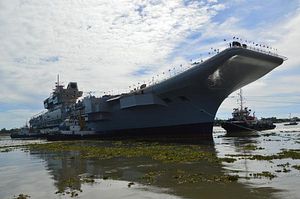Marking a symbolic milestone, India’s INS Vikrant, its first indigenously built aircraft carrier and the first of two planned Vikrant-class carriers, undocked at Cochin Shipyard. As of this week, the INS Vikrant, with a completed hull and internal structure, is free-floating and will go into static and dynamic trials soon.
The vessel was officially launched in August 2013 when it completed the first phase of its construction. Its undocking marks the successful conclusion of its second phase of construction. The carrier, which first left its dry dock in December 2011, is expected to have fully completed construction by 2016 and to be commissioned in 2017.
As Franz-Stefan Gady noted for The Diplomat some weeks ago, the Vikrant‘s launch was anticipating delays. The completion of phase two of construction was scheduled for late May — the undocking took place just two weeks off schedule. In general, India’s Indigenous Aircraft Carrier (IAC) project has encountered delays and budget overruns in recent years. Shortly after coming to office, Indian Prime Minister Narendra Modi’s government decided to accelerate construction on the project and increased funding allocations.
The Vikrant, at a length of 262 meters and a width of 60 meters, will field a range of aircraft and helicopters. Once completed, the Vikrant will carry up to 36 fixed-wing jets, including India’s MiG-29 K and India’s indigenous Light Combat Aircraft, the Tejas. The carrier will additionally carry up to ten helicopters, either Kamov Ka-31s, Westland Sea Kings, or indigenously-built Indian Dhruvs.
The Vikrant will be succeeded by a much larger 65,000 ton carrier, the INS Vishal. The Vishal, while the second carrier in the Vikrant-class, could be a very different sort of ship. In particular, India and the United States are planning on exploring cooperation on aircraft carrier technology. While the Vikrant will still field a ski-jump assisted short-take off but arrested recovery (STOBAR) system for its air wing — a technology only in use on Russian carriers and China’s Liaoning today — the United States may grant India access to General Dynamics’ advanced Electromagnetic Aircraft Launch System (EMALS) (see:”This US Technology Could Give Indian Aircraft Carriers an Important Edge“). During his recent visit to India, U.S. Defense Secretary Ashton Carter underlined the prospect of cooperation on aircraft carrier technology. (see:”US-India Collaboration on Aircraft Carriers: A Good Idea?“)

































